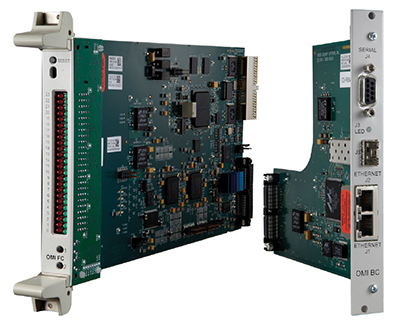The Road to Intelligent Intercoms

At the NAB Show, RTS introduced OmNeo, an IP-based open protocol audio architecture, that the company said would allow customers to buy intercom products based on features, rather than on protocol.
SEATTLE—It happens all the time in the outdoor broadcast world: A remote truck with a “Brand-X” intercom rolls in for a sports broadcast at a venue wired with a “Brand-Y” intercom.
“There’s one common way in which you can solve it, and that is a rather unintelligent way,” said Andreas Hilmer, director of marketing & communications, Riedel Communications in Wuppertal, Germany. “You would link via four wires. That’s the usual way that has been done by most of the trucks in the field.”
UNINTELLIGENT SOLUTION
The four wires consist of two wires audio in, two wires audio out on each end of the connection between the two intercom systems—in other words, one bidirectional audio path. Each additional bidirectional path takes another four wire connection.
“There’s nothing wrong with that— it’s done every day at every game and every sporting event everywhere,” said Vinnie Macri, product marketing manager at Clear-Com, an Alameda, Calif.-based provider of professional intercoms and other audio products. “The outcome is always the same, you always get to where you want to go. The shortcoming is that it’s not intelligent.”
Hilmer’s and Macri’s reference to a four-wire connection being unintelligent is not a slam on the brain-power that went into devising the four-wire solution. Using the word “unintelligent” is the remote truck industry’s way of describing the fact that with those four-wire connections you only get audio between the intercom systems. Missing are features commonplace within single-vendor intercom systems, such as a tally light illuminating on the director’s intercom console to indicate who is speaking to him or her.
There is a way of adding intelligence such as that tally function. “Traditionally those connections have been done through generic audio tie-lines, and through GPI [general purpose interface] contacts being passed back and forth for tally,” said Shawn Anderson, product manager for RTS Intercoms, a division of Bosch Security Systems in Burnsville, Minn. Such a solution requires a wired connection for each GPI deployed.
CLOSING THE GAP
But some recent developments have closed the gap between the performance of a connected pair of intercom systems from a single vendor versus two dissimilar intercom systems being coupled together.
Get the TV Tech Newsletter
The professional video industry's #1 source for news, trends and product and tech information. Sign up below.
Anderson said RTS released a new line of roducts at NAB referred to as, “OmNeo,’ a new technology, essentially a new architecture,” said Anderson. “OmNeo is basically an IP-based audio architecture, which implements what’s known as an open-control architecture. So there’s actually a control component.
“We’ve submitted it to the IEEE, and we’re pushing to have that ratified as an open public standard,” he said. “And as part of the OCA [Open Control Architecture] Alliance, there are actually nine founding members from multiple companies, and we’re all working on interoperability between all these different devices.”
From a customer standpoint, Anderson said, OmNeo will “allow them to buy products based on features, rather than on protocol.”
Hilmer noted that Riedel is “open to any kind interfacing to third-party products.” This led Riedel to develop a product called “Actor,” which “allows really seamless interfacing between a Riedel Artist intercom system and an RTS Telex intercom system. This includes all point-to-point connections, [such as] tally, as well as IFBs, group calls, conferences. This is really intelligent integration between the two systems.”
“We think that our clients, and our future clients, should be able to secure their previous intercom investments [and] to be able to able to proceed in the future.”
Using Actor to marry together two intercom systems from different vendors, “it’s like two trunked systems. So it’s not like you have all of the 1,024 ports available everywhere. It depends on the number of trunk lines.” While Actor passes the intelligence for tally, IFBs, group calls and the rest across between the two systems, the actual audio passes between the two intercom systems on trunk lines. “[Whatever number of audio paths you have between the two intercom systems,] you have that bottleneck, which you don’t have if you operate on a fiber ring.”
USING AES MADI
Macri said Clear-Com is not working on AVB (audio video bridging) compliant products that would be necessary to interconnect with RTS’s OmNeo IP-based system. “If I have $10 research money, I’m going to spend $2 on [AVB compliant products] when I could spend $2 on things people need, like maybe a new wireless solution or a new workflow solution that’s more current and more important than a network solution that nobody really cares about?”
He also said a hang-up in building a system where one vendor’s equipment talks with another is that “box A company is saying ‘I’m not giving them my protocol.’ And box B company is saying ‘I’m not giving anybody my protocol.’”
Macri pointed out that there’s a quick way to get the capacity of 64 four-wire connections between two dissimilar intercom systems through the use of an AES MADI link. MADI was developed originally for the audio industry as “a way to bring 64 audio channels very neatly and cleanly over on one piece of coax cable,” Macri said.
“Now all three intercom companies have MADI cards that go into the intercom frames, so now I can take a piece of coax from my Clear-Com frame, and tie it to Riedel’s frame, or RTS’s frame, and I can have bidirectional AES audio, up to 64 channels. It’s just audio, no data. It’s not an intelligent link, but it is high density.”
The takeaway from these recent developments is that connecting a pair of intercom systems from different vendors is not yet a perfect science, but it’s getting more intelligent.
